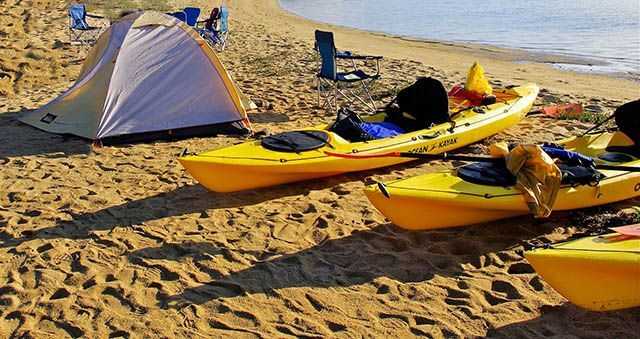
By: Nick Dyroff, Travel Country Pro Staff
[dropcap]T[/dropcap]he cooler nights are beginning to roll in pushing the bugs out and making for some perfect camping weather. Kayak camping can be very rewarding but also difficult if you don’t properly prepare, here are a few tips to make your next trip a success.
“Camping: Where you spend a small fortune to live like a homeless person”
If you are like me, when you load up your kayak to go fishing you bring everything but the kitchen sink. I was very excited when I laid out my gear for fishing and camping that everything could fit, I immediately regret that decision. The trick to packing for a kayak camping trip is to pack light, combine your items in the most efficient manner possible and have a setup plan.
Pack Light:
I stress packing light while I sit here at my computer still aching from my trip several days ago. My gear may have been out of sight but it wasn’t out of mind when I attempted a two mile paddle/peddle against the wind and strong currents with twenty minutes of daylight remaining. I recommend condensing your fishing tackle in to one container, bring only two rods and leave the giant gallon water jugs at home. Freeze your water bottles and divide your food and drinks among the group in to smaller coolers. If you are using live bait, plan on catching it once you are at your campsite to eliminate the added livewell weight. If you are fortunate enough to have a detachable kayak seat, don’t plan on bringing your favorite camping chair. As you lay everything out and begin eliminating, just remind yourself that you are looking to get away from it all and you will be lugging it all back at the end of the trip too. “My wife says, ‘camping is a tradition in my family,’ it was a tradition in everyone’s family until we invented the house.” –Jim Gaffigan
Combine and Pack:
Now that you have eliminated any unnecessary weight, it’s time to efficiently combine your gear for an easy unload and set up. On my recent trip I had very limited daylight to set-up, so my plan was to first open a beer, set up sleeping quarters, open another beer, gather wood and then unload the kayak. With this plan in place I packed a tarp, stakes, mallet, tent, and rope tightly in to the tent bag and stowed inside my Hobie Pro Angler front hatch. Rolled up tightly inside my sleeping bag were my mat, camping pillow, lantern and sleeping bag which also tucked nicely in to the front hatch. Plastic ammo boxes could stow away under my seat and provided a large water-tight solution for storing food, batteries, emergency signal devices, cooking/cleaning supplies and fire starting aids. A midsized backpack works great for storing clothes, tools, camelback/water, bug spray and extra headlamps which can be fastened to the back of the kayak seat. The bulkiest items which can’t be cleanly tucked away include the cooler and firewood which I secured in the back tank-well of the kayak over a foldable campfire cooking grate (which is a must have). The TackleWebs on my Hobie Vantage seat provided ample storage for my fishing accessories and tackle boxes while I used the pockets of my life vest for other odds and ends. In the future I will bring more figure nine carabiners for securing ropes and use color coded dry bags to eliminate searching for particular items. Consider balance and weight distribution when packing the kayak keeping heavier items low and centered. “Have you tried kayak camping? It’s in-tents!”
Setup Plan:
Having a setup plan is very helpful, especially if you have ADD like myself and end up wandering the campsite with a tent stake in one hand and a spatula in the other. Setting up shelter and acquiring kindling are much easier to do while the sun is still up, therefore I tackle those two projects first. If you have a new tent, I recommend setting it up in your yard prior to your trip to eliminate being “that guy,” in the group. Make sure there is a clear path from your tent to other areas you will be navigating later in the dark. If strong winds are prevalent in the area, consider using your tarp as a wind screen between two trees. If you bring a hammock, set it up last to eliminate playing limbo or falling asleep in it before you complete setting up. Once your shelter and bed are in order, finish unpacking your kayak and getting your fire going in a safe area.
I was never an Eagle Scout and I probably know three knots at the most, but I hope you can take something away from my experience and have yourself an enjoyable kayak fishing trip this winter. Be sure to stop by Travel Country for your camping supplies and support local businesses. “Lint from your navel makes a handy fire starter. Warning: Remove lint from navel before applying the match.” – Nick Dyroff